Hydroponics and Aquaponics: The New Darlings of Agriculture
Hi Friends,
For the past days, I have been sitting under some thorough tutelage, encompassing all spheres of life. I have learnt new things about myself, I have had people pick on my flaws, and I have particularly learned, unlearned and relearned a lot of things. I would put away the personal lessons for myself and go on to share some important things I picked up. Some of these important things are the concepts of Hydroponics and Aquaponics.
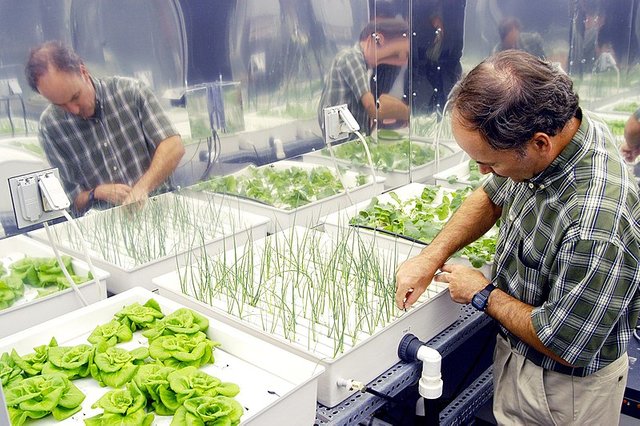
Image Source: Wikimedia by NASA, Public Domain Licensed
Like a trend, these phenomena have been been circling the realm of Agriculture and causing many to rethink the notion of planting and harvesting. Hydroponics and Aquaponics ain't exactly ain't new innovations, they have dwelt long enough to be called neighbours to the traditional forms of Agriculture we are familiar with. But really, an orientation or re-orientation in these regards would make think of Agriculture differently. You might even pick up a spot on its wide value chain network.
What is Hydroponics?
So, you be sitting in your room, thinking of the possibility of growing a garden without staining your hands with soil or getting creases on your corporate wear, and then, with your thinking cap on, you be finding a name for that kind of name for that kind of practice. Well, that name is Hydroponics. Hydroponics involves soil-less farming. It is a method of growing plants, especially vegetables, in water mixed with a nutrient solution. The nutrient concentration acts as a substrate for the crops.
Hydroponics sprouted from the discovery that soil does not in fact grow plants. They merely serve as a support system for the plants. What plants really need to survive are water, favourable climate conditions and lots and lots of nutrients. In leveraging on this, the plants grown via hydroponics are supported using artificial support substances like rockwool, clay pellets, peat moss, vermiculite, pelites etc.
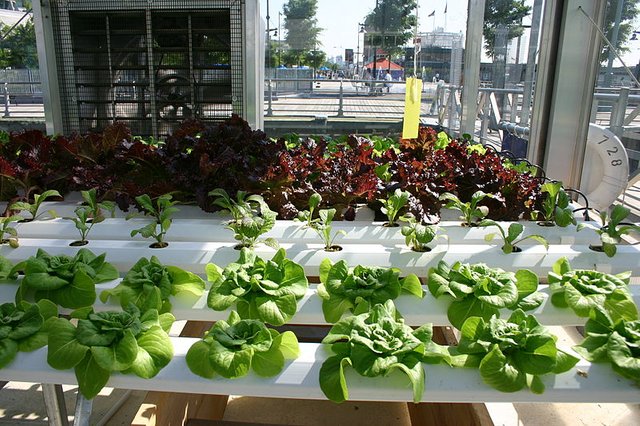
Image Source: Wikimedia by Ryan Somma CC BY SA 2.0
Hydroponics are usually practiced within the popular greenhouse culture, but rather than depend on soils to supply nutrients to the plants, liquid nutrients are injected into trays or vertical trellises containing clean water and the plants are grown within this culture. The whole idea is to make sure the roots of the plants touch the nutrient solutions and settle into them. The water constantly supplied through the proper irrigation system within the hydroponic greenhouse will help supply oxygen to the plants.
Also, given that the greenhouse will help trap the needed heat, the plants will be just in the right condition to grow well. Scientists estimate that compared to the 50% yield gotten from the traditional way of growing plants on a soil substrate, hydroponic plants give up to 99% yield because the conditions are favourable. Exotic vegetables of different species and varieties are the plants often grown in a hydroponic system. Talk of lettuce, spinach, broccoli, radish, tomato, cucumber, cabbage etc.
But even beyond depending on water to grow plants, there are other hydroponic practices that are both economical and effe. For one, rice husks and cocoa peas can act as a substrate placed within something as crude as a bucket for plants while water is constantly supplied to the plants via a dripping irrigation system. Tomatoes, cucumbers and other vegetables with a tendency to grow high are rather grown this way.
Advantages
The advantages of practising hydroponics are replete. As I said earlier, the growth ratio of traditionally planted crops and hydroponic products is very wide. As the plants are not troubled with trying to sap water and nutrients from the soil, the focus more on growing their leaves, fruits and size. Not just that, the practice of hydroponic allows seedlings to mature faster, thereby getting them ready for the market as soon as possible. Also, the fact that hydroponics allow crops to grow regardless of seasons or climates makes it possible for these exotic vegetables to be available all year round.
And surprising enough is the fact that hydroponics ensures water management. Because the greenhouse space is not open, there will be less evaporation of water and the water within the trays or vertical stacks can be efficiently utilized by the plants. And quite obvious is the fact that environmental pollution is largely avoided from soil contamination.
Disadvantages
Despite all the advantages of Hydroponics, it is not possible to overrule c the fact that it comes with challenges and problems. One of the most glaring problems is the expensive cost of setting up a soil-less form of farming as well as running it. Apart from the greenhouse structure that has to be set up, a sound irrigation system is also essential, this is not to exclude the purchase of the liquid nutrients that will be used.
Then again, a hydroponic system of farming requires proper and thorough monitoring as the pH level of the nutrients have to be carefully balanced. A slight imbalance can upset the plants. Also, in hydroponics, there is no room for so many mistakes like a failing pump, lack of electricity as at when due or a failure to pay attention to the plants for so much as a day.
But given the right conditions, the yield from hydroponics is worth all the attention.
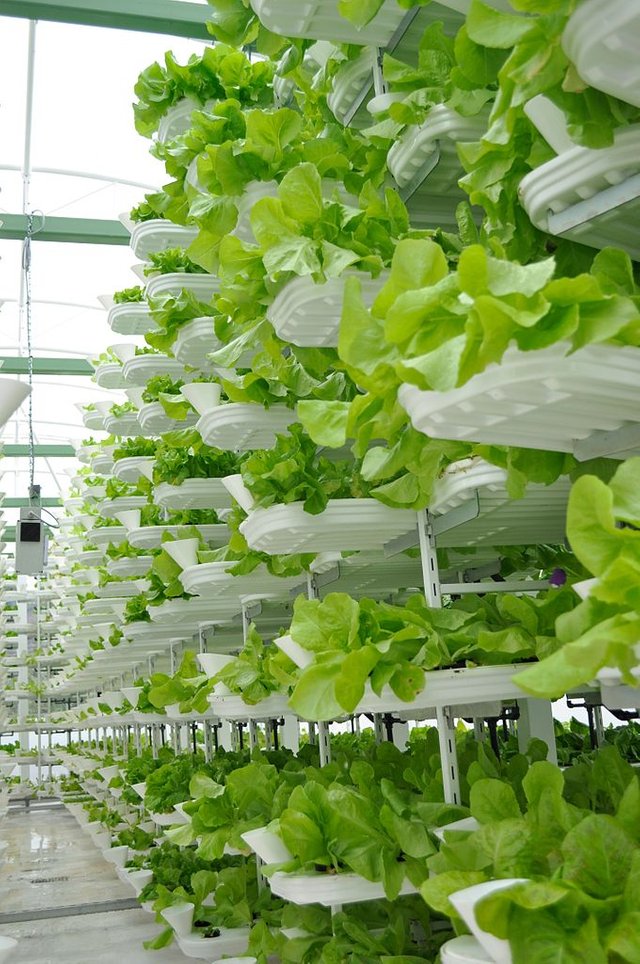
Image Source: Wikimedia by Valcentau CC BY SA 3.0
Types
There is no hard and fast rule to owning a hydroponic farm as there are different kinds, and these different types can be practiced individually or combined into a hybrid system. Virtually all the systems are segmentalised based on how the nutrients and water are conveyed to the plants. There is the drip system, for one, which allows the nutrients drip into the plants at regular intervals. Mediums such as rockwool, peat moss or coconut coir are used in this regard. The one disadvantage of the drip system is that it becomes possible for the droppers can easily be clogged. The Ebb and Flow, is a direct opposite of the drip system. Rather than let the nutrients drip, they are flooded all over the roots of the plants and then made to drain through pipes and back into the tanks. This system is repeated, giving the plants the needed nutrients to grow as well as recycling the nutrients for further use.
Wicking and Nutrient Film Technique (NFT) are some of the most practiced forms of hydroponics. While the Wicking system allows the roots of plants to be wicked and to the nutrient solution directly via a medium, NFT allows a continuous flow of nutrient solution to wash over the plants' roots. The Deep Water Culture is highly recommended as the roots of plants are kept in touch with the nutrient solution but also prevented from drowning via an aquarium air pump.
But then, with hydroponics as with every other thing, there is always room for improvisation.
What is Aquaponics?
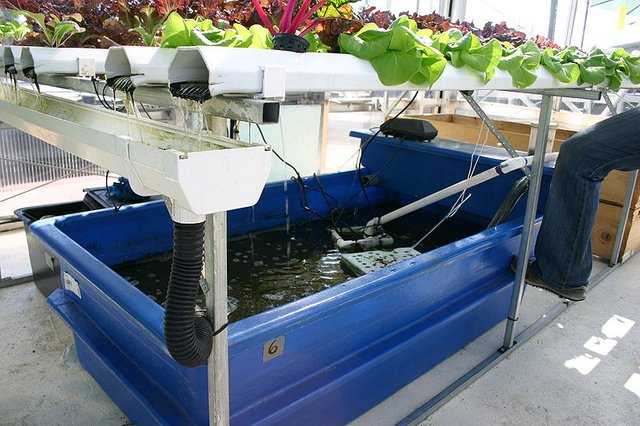
Image Source: Wikimedia by Ryan Somma CC BY A 2.0
Aquaponics is altogether related to hydroponics. It is the combined practice of aquaculture and hydroponics. In this sense, it involves the rearing of fished and the planting of crops using the nutrient solution or concentrate gotten from the water used in rearing the fishes. Fishes and plants grown in one integrated system, sweet, right?
The plants do not just collect organic nutrients from the fishes, they also filter the water for the fishes. But plants and fishes are not the only ones involved in this integrated ecosystem, microbes also have a part to play. These bacteria (the good nutrifying ones) convert the ammonia on the fish water to nitrites, and then to nitrates. The fish waste, in turn, is converted to vermicompost. And both the nitrate and vermicompost provide the needed nutrients for plants to grow.
Aquaponics does both the separate fields of aquaculture and hydroponics by synergising them, thereby getting rid of the problems inherent in both of them. In the first place, the hydroponics system relies on artificial nutrients that are expensive and have to be balanced carefully for yield to be actualised. Also, theneed to dispose the water used Ina hydroponic system can be quite problematic and not disposing the water can expose the plants to diseases.
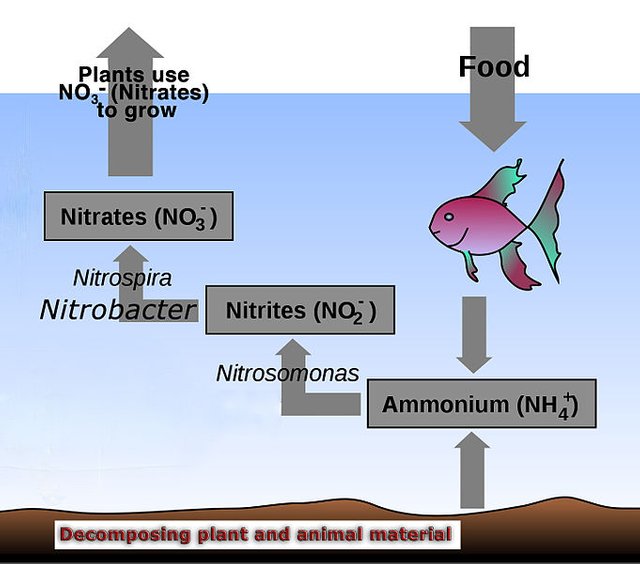
Image Source: Wikimedia by Friendlyaquaponics CC BY SA 3.0
On the other hand, the one problem with aquaculture is the need to dispose quite a lot of nutrient imbued water as well as replace the ponds and tanks with clean water. The failure to dispose the water expose the fishes to uncommon diseasea. And then, when the water is also disposed into streams, it toxifies the streams and rivers.
All these problems are solved by Aquaponics. First off, it's a natural ecosystem; expensive nutrient solutions, petro-chemical herbicides or pesticides are avoided and the inexpensive, organic feed given to the fishes are what is needed to grow the fishes who, in turn, help grow the crops. Again, as the ammonia water is constantly recycled between the fishes and the plants, the environment will not be toxified. The aquaponic system also fits different sizes of space and budgets. And most importantly, harvest will not just all year round, it will also come in double folds.
True enough, hydroponics and aquaponics have come on as the new darlings of agriculture, and although they both have their challenges, they have given us one most important gift: the ability to make a fun-filled, exciting, and respectable career out of agriculture. With these means of farming, roses can indeed be red, daffodils can indeed blossom and water can indeed be sculpted into life
Get your post resteemed to 72,000 followers. Go here https://steemit.com/@a-a-a
Hi @funmiakinpelu!
Your post was upvoted by utopian.io in cooperation with steemstem - supporting knowledge, innovation and technological advancement on the Steem Blockchain.
Contribute to Open Source with utopian.io
Learn how to contribute on our website and join the new open source economy.
Want to chat? Join the Utopian Community on Discord https://discord.gg/h52nFrV
For a fact, hydroponics is fast becoming the new face of agriculture in developed countries, along with Aeroponics. And for me, the benefits always outweigh the challenges, one just needs to select the right type to practice. Well done.
Its a good write up. Makes me remember your article on hydroponics and aeroponics.